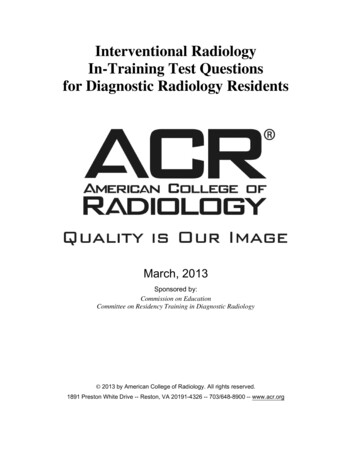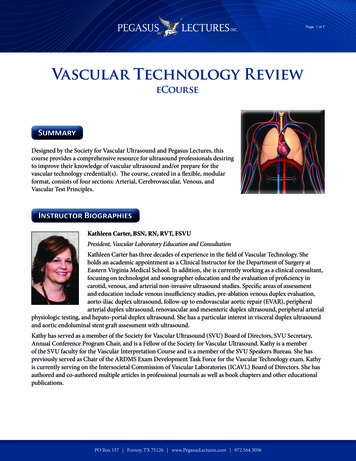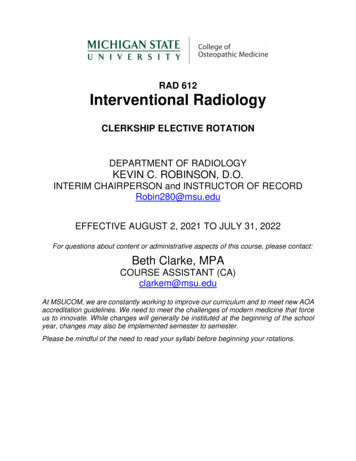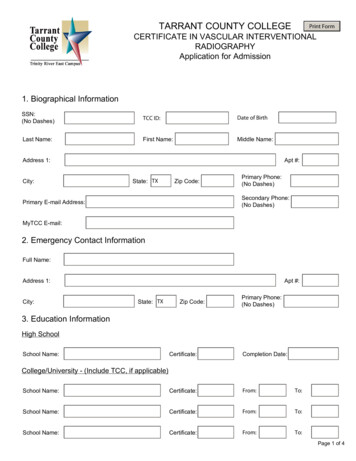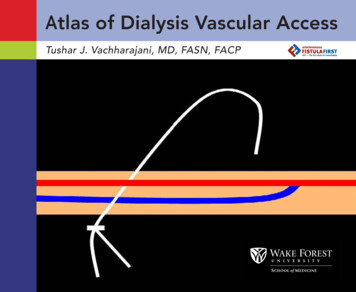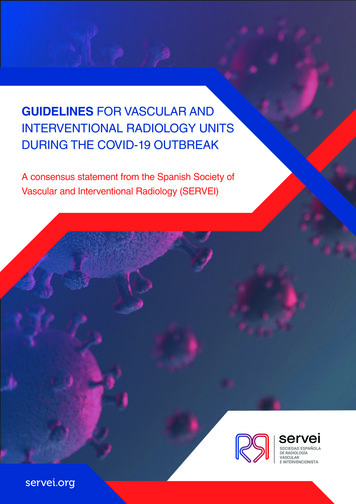
Transcription
GUIDELINES FOR VASCULAR ANDINTERVENTIONAL RADIOLOGY UNITSDURING THE COVID-19 OUTBREAKA consensus statement from the Spanish Society ofVascular and Interventional Radiology (SERVEI)servei.org
GUIDELINES for vascular and interventionalradiology units during the COVID-19 outbreak: aconsensus statement from the Spanish Society ofVascular and Interventional Radiology (SERVEI)Guidelines for vascular and interventional radiology units during theCOVID-19 outbreak: a consensus statement from the Spanish Society ofVascular and Interventional Radiology (SERVEI)Miguel A. de Gregorio1, Laura Serrano2, Fernando López Zárraga3, Mariano Magallanes4,María Cruz Piquero5, José A. Guirola1, J.M. Abadal6, Santiago Méndez7, Mercedes Pérez8,José R. Pulpeiro9, Abel Gregorio10 Antonio López11, Arantxa Gelabert12, Jimena González13,Enrique Juliá14, Miguel Casares14, Anna Alguersuari16.1Interventional Radiology Unit. Hospital Clínico Universitario Lozano Blesa. Zaragoza.2Department of Occupational Health and Safety. Hospital Clínico Universitario Lozano Blesa. Zaragoza.3Interventional Radiology Unit. Hospital Universitario de Álava. Sede Txagorritxu. Vitoria-Gasteiz.4Interventional Radiology Unit. Hospital Povisa. Vigo.5Nursing staff. Unidad de Radiología Intervencionista. Hospital Clínico Universitario Lozano Blesa. Zaragoza.6Interventional Radiology Unit. Hospital Severo Ochoa. Leganés (Madrid).7Interventional Radiology Unit. Hospital Puerta de Hierro. Madrid.8Interventional Radiology Unit. Hospital Vall d’Hebron. Barcelona.9Interventional Radiology Unit. Hospital Lucus Augusti. Lugo.10Interventional Radiology Unit. Hospital Denia-Marina Salud. Denia (Alicante).11Interventional Radiology Unit. Hospital de Basurto. Bilbao.12Interventional Radiology Unit. Hospital Parc Tauli. Sabadell.13Interventional Radiology Unit. Hospital Clínico Universitario San Carlos. Madrid.14Interventional Radiology Unit. Complejo Hospitalario de Albacete. Albacete.15Interventional Radiology Unit. Red Asistencial Juaneda. Palma de Mallorca.16Interventional Radiology Unit. Health Diagnostics. Hospital Universitari General de Catalunya. Sant Cugat delVallès (Barcelona).1
GUIDELINES for vascular and interventionalradiology units during the COVID-19 outbreak: aconsensus statement from the Spanish Society ofVascular and Interventional Radiology (SERVEI)ABSTRACTThe World Health Organization (WHO) recently declared the outbreak of COVID-19, caused byinfection with the SARS-cov2 virus, a global pandemic.To ensure that vascular and interventional radiology units in Spain continue to work optimallythrough the changing situations during this public health emergency, the Spanish Society ofVascular and Interventional Radiology (SERVEI) elaborated a consensus statement.Based on the recommendations from the WHO, the Spanish Ministry of Health, regional healthdepartments in Spain, and various hospitals, these guidelines aim to orient professionals inorganizing units and managing patients during the COVID-19 outbreak to help ensure patients’and professionals’ safety.The implementation of these guidelines will depend on the particular circumstances andresources available at each unit.KeywordsCOVID-19, prevention, coronavirus, interventional radiology suite2
GUIDELINES for vascular and interventionalradiology units during the COVID-19 outbreak: aconsensus statement from the Spanish Society ofVascular and Interventional Radiology (SERVEI)INTRODUCTIONThe appearance of the SARS-coV2 virus and outbreak of COVID-19 has important implicationsfor vascular and interventional radiology units. The first confirmed case of SARS-CoV-2 infectionin Spain was identified in January 2020, and the first death attributed to COVID-19 occurred onFebruary 13. On March 11, the WHO declared COVID-19 a pandemic [1], and on March 15 theSpanish government declared it a national health emergency.In Spain, although the pandemia has been especially concentrated in certain areas (Madrid,Basque country, Rioja, and Navarra, and to a lesser extent in Valencia and Catalonia), caseshave been reported in all regions.Like other coronaviruses, COVID-19 primarily causes respiratory symptoms, running frommild syndromes similar to a common cold to systemic inflammatory response syndrome withsevere interstitial bronchopneumonia leading to respiratory failure, septic shock, and death.Although 80% of patients have only mild symptoms, thousands of others have died.Risk factors for developing more severe disease include advanced age (patients aged 60have increased risk and those aged 80 years have the highest mortality from COVID-19),hypertension (the virus enters cells by binding to ACE-2 receptors on the cell membrane),cardiorespiratory disease (it seems the virus is especially cardiotropic), immunodepression,and diabetes.Because some infected individuals remain asymptomatic and can transmit the disease, it isimpossible to know how contagious or lethal the virus is until a reliable estimate of the numberof people who have been infected becomes available.VIR teams play an important role in the clinical and therapeutic management of a wide spectrumof diseases. The outbreak of COVID-19 and orders from local and national health authoritieshave drastically deranged the operation of the vast majority of VIR units. The Spanish Societyof Vascular and Interventional Radiology (SERVEI) is committed to ensuring the best possibleoutcomes for all patients. Given the threat posed by the current situation, SERVEI recognizes theneed to define protocols for managing patients with confirmed COVID-19, those with suspectedbut unconfirmed COVID-19, and those without any signs or symptoms of the disease [6].VIR teams comprise few, highly specialized professionals (nurses, technicians, aides, andphysicians) who work together in compact spaces, so the risk of contagion among professionalsis high. Infection of a single professional could result in the quarantine of many team members,threatening the unit’s ability to provide care for the patients who need it.To guarantee the safety of patients and professionals and the quality of care in VIR units, theSERVEI has elaborated the following guidelines.3
GUIDELINES for vascular and interventionalradiology units during the COVID-19 outbreak: aconsensus statement from the Spanish Society ofVascular and Interventional Radiology (SERVEI)DEFINITIONS (Source: Procedures to follow in patients infected with the new coronavirus COVIDsars-2. Ministry of Health of the Government of Spain. 15 March 2020) CONFIRMED infection: case fulfilling laboratory criteria: PCR positive for a specific gene[RdRp or S] or positive for 2 genes used for screening [E or N]. PROBABLE infection: case with inconclusive laboratory findings for SARS-CoV-2; thesecases are sent to the National Microbiology Laboratory for confirmation. Infection RULED OUT: case in which laboratory findings are negative for SARS-CoV-2. POSIBLE infection: patient with mild acute respiratory symptoms that do not meet thecriteria for diagnostic testing. CLOSE CONTACT case: Anyone who has provided care for a patient with a probable or confirmed infection whilethe patient was symptomatic: healthcare professionals without adequate protectivemeasures interacting with the patient and family members or other individuals in closephysical contact with the patient. Anyone who has been within 2 meters of a person with a probable or confirmed infectionin a confined space (e.g., cohabitants or visitors). Anyone on an airplane seated within a radius of two seats from a person with a probableor confirmed infection while that person was symptomatic, as well as crew memberswho had direct contact with that person.The preventive medicine or occupational health department at each hospital will assess eachprofessional’s situation individually, taking into account aspects related to the working environmentas well as the type and duration of exposure.PLANNING AND STRATEGY FOR VIR UNITSWhen possible, VIR units should be organized into independent teams that do not interact witheach other, so that if one team must be quarantined, the remaining team(s) can continue toprovide care.It is highly recommendable to distribute work into morning and afternoon shifts on alternative daysto ensure that the different teams have different schedules and do not interact with each other.4
GUIDELINES for vascular and interventionalradiology units during the COVID-19 outbreak: aconsensus statement from the Spanish Society ofVascular and Interventional Radiology (SERVEI)Whenever possible, professionals should be isolated from possible contact with the contagion;thus, it is important to facilitate remote working (e.g., reporting CT angiograms from home), possiblywith professionals rotating in weekly shifts. If this approach is unfeasible, it is recommended thatprofessionals be organized in different teams dedicated to different, cyclical activities (e.g., onegroup reporting vascular/oncologic studies and the other carrying out activities in the suite) andthat members of different teams maintain a safe social distance (1.5 m) from one another.If the unit has more than one angiography suite, one or more should be reserved for patients withprobable or confirmed infections and the other(s) for those in whom infection has been ruled out.Protective measures must be updated to comply with guidelines and protocols based on the latestscientific evidence about transmission. It is essential for all professionals to have the appropriateprotective equipment for all procedures.PATIENTS TO BE ATTENDEDGiven the extreme scarcity of available hospital beds due to this health emergency, activity shouldbe limited to medical emergencies and high-priority procedures (e.g., oncologic patients). Nointerventions should be done unless beds are available. All elective or nonessential proceduresshould be postponed.Units should establish a list of procedures that should be considered urgent or maximum priority(Annex II).Oncologic patients account for more than 40% of the activity in VIR units. The VIR team must reacha consensus with the patient’s attending team regarding the degree of urgency and the possibility ofpostponing treatment or of alternative treatments on a case-by-case basis taking into considerationthe availability of hospital beds.Likewise, it is fundamental to coordinate with the department of anesthesia and reanimation toassess the availability of resources and the foreseeable duration of hospitalization for each candidatefor treatment.Given the scarcity of hospital beds and difficulty of admission to intensive care units, it is essentialto weigh the risk of complications in elective oncologic procedures.Standard care pathways based on safety and quality regulations must not be altered to allowimmediate discharge after procedures in cases requiring surveillance (core biopsy of visceralorgans, tumor ablation, etc.).5
GUIDELINES for vascular and interventionalradiology units during the COVID-19 outbreak: aconsensus statement from the Spanish Society ofVascular and Interventional Radiology (SERVEI)PREVENTIVE MEASURES AND REGULATIONSGeneral To avoid unnecessary deployment of resources, VIR nursing staff in coordination withward nursing staff must complete a safety checklist before transferring patients to the VIRsuite; this checklist must include the classification of the patient’s SARS-CoV-2 status asinfection ruled out or confirmed or possible-probable infection (cough, fever, sorethroat). Patients transferred from wards to the VIR suite must wear surgical masks from the timethey leave the ward until they return to the ward (i.e., during transfer to the VIR suite,during procedures, and during transfer back to the ward). Likewise, orderlies transportingpatients must wear masks and gloves. All professionals must wear surgical scrubs and surgical masks throughout the workshift. Street clothing is FORBIDDEN in VIR departmental areas. All professionals must wash their hands frequently Workstations must be individualized as far as possible: each station should be assignedto a single professional (or if this is unfeasible, to two professionals), and professionalsshould use only the station to which they have been assigned, Workstations must bespaced at least 1.5 meters apart. It might be useful to plastic keyboard covers to facilitatecleaning. It is essential to remove personal protective equipment and to wash hands thoroughlybefore using consoles and before using computers to review images or to write reports. If voice recognition software is used for reporting on shared workstations, professionalsshould wear surgical masks when dictating reports. Protective aprons and thyroid shields must be cleaned daily with at least 1 minuteexposure to ethanol (62%-71%). As far as possible, consultations with professionals from other departments should bedone remotely.6
GUIDELINES for vascular and interventionalradiology units during the COVID-19 outbreak: aconsensus statement from the Spanish Society ofVascular and Interventional Radiology (SERVEI)ATTENDING PATIENTS CONSIDERED LESS LIKELY TO HAVE COVID-19(SARS-COV-2 INFECTION RULED OUT OR POSSIBLE)It may be necessary to treat patients who are asymptomatic or have mild symptoms but havenot been tested for COVID-19. In these cases, it is essential to exercise extreme caution toensure preventive and protective measures, especially when patients are referred from theemergency department, intensive care unit, or group living facilities (e.g., nursing homes, longterm care facilities, prisons, etc.).Recommendations PATIENTS: must wear surgical masks from the point of referral. Patients’ hands shouldbe sanitized before entering the VIR suite. PHYSICIANS, NURSES, AND NURSES AIDES: must wash their hands and wearconventional surgical masks (if possible with a plastic screen), sterile waterproof gowns,sterile gloves, disposable head coverings (never cloth head coverings), and radiologicalgoggles. Full face shields are recommended only for procedures that involve a risk ofgenerating aerosols. VIR procedures that could generate aerosols include percutaneous gastrostomy;placement or dilation of an esophageal, gastric, duodenal, or tracheal stent; embolizationof bronchial arteries; procedures in tracheostomized patients; and procedures requiringintubation. In high-risk epidemic foci or when a situation of community transmission has beendeclared, some scientific societies and workgroups recommend performing chest CTin urgent patients for whom previous verifiable information about possible symptoms isunavailable and in those who have been in contact with infected persons. Nevertheless,there is no wide consensus about the need for chest CT in these patients and the decisionto perform chest CT should depend on the situation in the local community (high risk:community transmission) and be taken together with attending physicians and thoracicradiologists.7
GUIDELINES for vascular and interventionalradiology units during the COVID-19 outbreak: aconsensus statement from the Spanish Society ofVascular and Interventional Radiology (SERVEI)ATTENDING PATIENTS CONSIDERED LIKELY TO HAVE COVID-19(SARS-COV-2 INFECTION PROBABLE OR CONFIRMED)General recommendations Only professionals who are absolutely necessary for the procedure should be involvedin the patient’s care. The doors to the VIR suit must be kept closed. Laminar air flow in suites should be turned off during procedures to avoid spreadingcontagions to areas outside the suite. Only fundamental material should be brought into the suite. To minimize movements inand out of the suite, it is important to place accessory material that might be necessary todeal with eventualities nearby and to have a nurse or aide bring this material into the suiteif it is required. It could be helpful to have packs of material ready to deal with the mostcommon emergencies (e.g., embolization pack, nephrostomy pack, stroke pack, etc.). All packages delivered to the VIR unit should be opened with gloves on and packagingmaterial should be removed after the contents have been removed. Professionals should avoid leaving the VIR suite with any contaminated item of personalprotective equipment. All used and unused material must be disposed of in dedicated waste receptacles: class3 containers inside the suite as well as in the room through which the suite is exited. It is important to protect the anesthesia station, the injector, and the monitoring apparatuseswith clear plastic covers that allow them to be used without direct contact. To minimize the movement of patients with a high risk of being infected, ultrasoundguided procedures (e.g., placing drainages or vascular accesses) should be performed atbedside whenever possible, following established protocols (see the Spanish UltrasoundSociety guidelines).Recommendations for moving patients from gurneys to operating tables Professionals moving patients between beds and operating tables most wear high-riskpersonal protective equipment (i.e., head covering, FFP2 mask, face shields, waterproofgown or plastic apron, and gloves). Once the patient has been transferred, personnel must remove the equipment, followingthe instructions provided below.8
GUIDELINES for vascular and interventionalradiology units during the COVID-19 outbreak: aconsensus statement from the Spanish Society ofVascular and Interventional Radiology (SERVEI)Personal protective equipment PATIENTS: should be provided with surgical masks, not with FFP2 masks. FFP2 masksare designed to protect the wearer, not to function as a barrier. The air expelled throughthe FFP2 mask valve can be contaminated. PHYSICIANS AND NURSES: must comply with hand-cleansing protocols, wearwaterproof gowns (unless a plastic apron can be worn), two pairs of gloves, protectivegoggles or plastic face shield, head coverings, and FFP2 or FFP3 masks with surgicalmasks over them, especially if materials are in short supply and must be reused(recommended by the Ministry of Health). Annex III lists the filtrating capacity of thedifferent types of masks.Recommendations for putting on personal protective equipment1. Remove rings and jewelry. Avoid wearing nail polish.2. Place shoe covers over footwear. Wear only closed clogs.3. Tie hair back and put on protective head covering.4. Put on radiological protective gear (lead glasses, apron, thyroid shield).5. Carry out hand hygiene according to surgical protocol.6. Put on FFP2-FFP3 mask, adjusting the metallic band over the bridge of the nose andplacing one elastic band over the top of the ears and the other below the ears. Make surethat there are no leaks: place your hand over the valve to check sealing.7. Put on goggles or face shield.8. Put on a surgical cap.9. Place a standard surgical mask over the FFP2-FFP3 (when materials are scarce).10. Cleanse hands with sanitizer.11. Put on the first pair of gloves.12. Put on a sterile surgical gown.13. Put on the second pair of gloves.9
GUIDELINES for vascular and interventionalradiology units during the COVID-19 outbreak: aconsensus statement from the Spanish Society ofVascular and Interventional Radiology (SERVEI)Recommendations for removing personal protective equipmentInside the suite:1. Remove your gown and outer pair of gloves simultaneously, and place these itemsin the designated waste receptacle (class 3 container). To avoid generating aerosols,keep movement of the gown to a minimum.2. Remove the external head covering and place it in the class 3 container.3. Remove shoe covers and place them in the class 3 container.4. On leaving the suite, stand with both feet on the bleach-impregnated cloth.Outside the suite:1. Remove the inner pair of gloves.2. Wash your hands.3. Remove goggles or face shield while keeping your eyes closed.4. Sanitize your hands with gel.5. Remove your mask (touching only the elastic bands).6. Wash your hands again.IMPORTANT!1. Gowns and external gloves should NEVER leave the suite.2. It is forbidden to be in the suite without an FFP2-FFP3 mask.10
GUIDELINES for vascular and interventionalradiology units during the COVID-19 outbreak: aconsensus statement from the Spanish Society ofVascular and Interventional Radiology (SERVEI)Finalizing the procedure1. Put on a clean pair of gloves and disinfect the goggles/face shield with sanitizing wipes ordisinfectant. It is recommendable to keep all goggles in a single basin and that only oneperson handle and clean them (first with soap and water or disinfecting wipes and thenwith sanitizing fluid).2. All the material used in the procedure must be discarded in the group 3 container.3. Consider changing scrubs.4. Patients must wear surgical masks AT ALL TIMES.5. Orderlies must wear masks (preferably FFP2-FFP3) and gloves AT ALL TIMES.Cleaning the suite Cleaning staff must wear personal protective equipment (if available). The suite must be cleaned and disinfected according to protocol (using specificprocedures to protect cleaning staff from contact with airborne pathogens and pathogenson surfaces). All areas that may have come in contact with the patient must be cleaned. To reduce the risk of the presence of aerosols, it is recommendable to wait until 30 to 60minutes after the procedure before cleaning the suite.11
GUIDELINES for vascular and interventionalradiology units during the COVID-19 outbreak: aconsensus statement from the Spanish Society ofVascular and Interventional Radiology (SERVEI)HOW TO PROCEED IF MATERIAL IS LACKING (Ministry of Health(Government of Spain); March 18, 2020)12
GUIDELINES for vascular and interventionalradiology units during the COVID-19 outbreak: aconsensus statement from the Spanish Society ofVascular and Interventional Radiology (SERVEI)13
GUIDELINES for vascular and interventionalradiology units during the COVID-19 outbreak: aconsensus statement from the Spanish Society ofVascular and Interventional Radiology (SERVEI)ANNEX I - USE OF MEDICATION IN THE SARS-COV-2 SCENARIOAlthough the data regarding many of the supposed interactions with antiretrovirals and withhydroxychloroquine are inconclusive and are not backed by sufficiently robust evidence, thefollowing general terms can help orient clinicians on the use of medication in patients who mightbe infected with SARS-CoV-214:The following drugs are NOT CONTRAINDICATED: AAS Ephedrine Tirofiban Dopamine Heparin sodium Dobutamine rtPA Propofol Tenecteplase Paracetamol Omeprazole Mepivacaine Ranitidine Metoclopramide AdrenalineAlthough there is no evidence thatangiotensin-converting enzyme inhibitorsor angiotensin II receptor antagonistsshould be contraindicated, it isrecommended that they be replacedwith other drugs in patients hospitalizedfor COVID-19. Atropine PhenylephrineLabetalol can be used in combinationwith antiretrovirals but NOT withhydroxychloroquine.As far as possible, the following drugs SHOULD BE AVOIDED: Dexamethasone/methylprednisolone Clopidogrel and ticagrelor (use prasugrelinstead, but NOT in cases of ischemicstroke because it increases the risk ofintracranial bleeding). Beta-blockers because they interactwith hydroxychloroquine Ondansetron.The following drugs can be USED WITH CARE: Intravenous midazolam (oral administration is contraindicated because retrovirals increaseserum levels of midazolam).14
GUIDELINES for vascular and interventionalradiology units during the COVID-19 outbreak: aconsensus statement from the Spanish Society ofVascular and Interventional Radiology (SERVEI)ANNEX II - PROCEDURES CONSIDERED URGENT AND LEVEL IPRIORITYIt is important to reduce the non-urgent workload because infection-control measures prolongthe time required for procedures and require the intervention of more professionals. Most caseswill be patients with suspected rather than confirmed infections.CITATION PLAN IN COVID-19 SITUATION IN IR SUITES (source: RSNA)PROCEDURES THAT CAN BESCHEDULEDPROCEDURES THAT SHOULD BERESCHEDULED OR POSTPONEDEmergenciesInterventions for chronic venous diseaseParacentesis / ThoracocentesisProstatic artery embolizationPercutaneous drainage of abscessesUterine fibroid embolizationPercutaneous nephrostomyEmbolization for pelvic congestion syndromePercutaneous biliary drainageEndoleak embolizationInterventions related to dialysis accessesEmbolization of pulmonary arteriovenousmalformationsPlacement of ICV filters**Removal of ICV filtersPercutaneous ablation of lesions*Transjugular biopsyTransarterial chemoembolization*TIPS for refractory ascitesCentral venous access*Replacement of functioning cathetersLymphatic interventions*Venograms for planning internal arteriovenousfistulasOrgan biopsies** Assess on a case-by-case basis, considering the need for beds.** If presurgical, confirm that the schedule for the operation has not been changed.15
GUIDELINES for vascular and interventionalradiology units during the COVID-19 outbreak: aconsensus statement from the Spanish Society ofVascular and Interventional Radiology (SERVEI)ANNEX III IFICATION OF FFP N9595%N9999%N100100%98%* % FE (Minimum Filtration Efficiency) * FE (minimum filtration efficiency) minimum percentage of airborneparticles 0.3 mm filtered16
GUIDELINES for vascular and interventionalradiology units during the COVID-19 outbreak: aconsensus statement from the Spanish Society ofVascular and Interventional Radiology (SERVEI)CHARACTERISTICS OF THEMASKEFFICIENCY OF THEMASKN95 masks withoutrespirator valveUSEThey can be reusedAlso known as N95 respirators,or used for longthese masks effectively filterairborne particles and provideThey block 95% ofadequate protection againstparticles 0.3 μmairborne transmission of respiratoryperiods of time. Theyshould be discardedwhen damaged,deformed, wet, orinfections.dirty.N95 masks withThe characteristics of these masksrespirator valveare the same as those of N95Like N95 masksmasks without respirator valves.without respirators,The respirator valves have severalTheir efficiency is similarthey can be reused ordelicate parts that allow exhaledto that of N95 withoutused for long periodsbreath to flow out but do not allowrespirator valves; they blockof time. They shouldparticles to flow in. This design 95% of particles 0.3 μmbe discarded whenfacilitates exhalation and helpsdamaged, deformed,reduce the accumulation of heat andwet, or dirty.moisture.Surgical masksThe filtration efficiencyof surgical masks varies.These masks are used to provideIn general, they can filterhealthcare professionals or relatedparticles 5 μm. They havestaff with basic protection. Theyan external layer that repelsprotect wearers’ from spattering andwater, preventing drops fromdroplets that can contain germs.entering the mask, and anSingle use.intermediate layer that filtersparticles.General medicalmasksThese disposable masks areThese masks do not fulfilldesigned for general medicalthe minimum requirementsprocedures, mostly in ordinaryfor filtering particles andenvironments to block particlesmicroorganisms; they are(e.g., pollen) rather than pathogenicless efficient than surgicalmicroorganisms.masks and FFP masks.These masks are used to maintainThese masks only filterheat and block larger particles suchlarge particles like soot oras dust.dust.Single use.Cotton masksWashable andreusable.17
GUIDELINES for vascular and interventionalradiology units during the COVID-19 outbreak: aconsensus statement from the Spanish Society ofVascular and Interventional Radiology (SERVEI)The information in this document is valid for the current scenario (27 March 2020). No oneknows how the situation will develop. Although models based on what has happened in othercountries are available, each country is unique and differs from others in many respects.ACKNOWLEDGEMENTSThe authors thank the Spanish Society of Cardiology, especially the authors of the consensusdocument published in REC Interventional Cardiology in March 2020.We also thank our colleagues responsible for the following documents that were consulted inelaborating these recommendations. Managing vascular and interventional radiology suites used for interventionalneuroradiology procedures during the COVID-19 outbreak”, a protocol from the HospitalUniversitario Virgen del Rocío (Seville). Vascular and interventional radiology protocol from the Hospital Parc Taulí (Sabadell). Vascular and interventional radiology protocol from the Hospital Universitario de Basurto(Bilbao). "Action Protocol for Vascular and Interventional Radiology departments during thecoronavirus outbreak (COVID-19). Consensus Document", published in RevistaIntervencionismo.REFERENCES1. World Health Organization. Coronavirus disease (COVID-19) outbreak. Avalaible at: https://www.who.int.2. Guan W, Ni Z, Hu Y, Liang W, Ou C, He J, et al. Clinical Characteristics of CoronavirusDisease 2019 in China. N Engl J Med. 2020 Feb 28. doi: 10.1056/NEJMoa2002032.3. Hunter P. The spread of the COVID-19 coronavirus: Health agencies worldwide prepare forthe seemingly inevitability of the COVID-19 coronavirus becoming endemic. EMBO Rep.2020 Mar 17:e17:e50334. doi: 10.15252/embr.202050334.4. Livingston E, Bucher K. Coronavirus Disease 2019 (COVID-19) in Italy. JAMA. 2020 Mar 17.doi: 10.1001/jama.2020.4344.5. Cinesi C, Pañuelas O, Lujan M, et al. Recomendaciones de consenso respecto al soporterespiratorio no invasivo en el paciente adulto con insuficiencia respiratoria aguda secundariaa infección por SARS-CoV-2. Med Intensiva. 2020 Mar 18. doi: 10.1016/j.medin.2020.03.00518
GUIDELINES for vascular and interventionalradiology units during the COVID-19 outbreak: aconsensus statement from the Spanish Society ofVascular and Interventional Radiology (SERVEI)6. Romaguera R, Cruz-González I, Ojeda S, Jiménez-Candil J, et al. Gestión de las salasde procedimientos invasivos cardiológicos durante el brote de coronavirus
Patients transferred from wards to the VIR suite must wear surgical masks from the time they leave the ward until they return to the ward (i.e., during transfer to the VIR suite, during procedures, and during transfer back to the ward). Likewise, orderlies transporting patients must wear masks and gloves.
